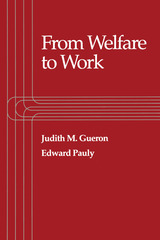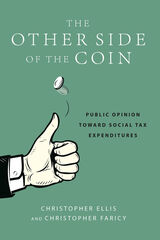2 books about Federal aid to public welfare

From Welfare to Work
Judith M. Gueron
Russell Sage Foundation, 1991
From Welfare to Work appears at a critical moment, when all fifty states are wrestling with tough budgetary and program choices as they implement the new federal welfare reforms. This book is a definitive analysis of the landmark social research that has directly informed those choices: the rigorous evaluation of programs designed to help welfare recipients become employed and self-sufficient. It discusses forty-five past and current studies, focusing on the series of seminal evaluations conducted by the Manpower Demonstration Research Corporation over the last fifteen years. Which of these welfare-to-work programs have worked? For whom and at what cost? In answering these key questions, the authors clearly delineate the trade-offs facing policymakers as they strive to achieve the multiple goals of alleviating poverty, helping the most disadvantaged, curtailing dependence, and effecting welfare savings. The authors present compelling evidence that the generally low-cost, primarily job search-oriented programs of the late 1980s achieved sustained earnings gains and welfare savings. However, getting people out of poverty and helping those who are most disadvantaged may require some intensive, higher-cost services such as education and training. The authors explore a range of studies now in progress that will address these and other urgent issues. They also point to encouraging results from programs that were operating in San Diego and Baltimore, which suggest the potential value of a mixed strategy: combining job search and other low-cost activities for a broad portion of the caseload with more specialized services for smaller groups. Offering both an authoritative synthesis of work already done and recommendations for future innovation, From Welfare to Work will be the standard resource and required reading for practitioners and students in the social policy, social welfare, and academic communities.
[more]

The Other Side of the Coin
Public Opinion toward Social Tax Expenditures
Christopher G. Faricy
Russell Sage Foundation, 2021
Despite high levels of inequality and wage stagnation over several decades, the United States has done relatively little to address these problems—at least in part due to public opinion, which remains highly influential in determining the size and scope of social welfare programs that provide direct benefits to retirees, unemployed workers or poor families. On the other hand, social tax expenditures—or tax subsidies that help citizens pay for expenses such as health insurance or the cost of college and invest in retirement plans—have been widely and successfully implemented, and they now comprise nearly 40 percent of the spending of the American social welfare state. In The Other Side of the Coin, political scientists Christopher Ellis and Christopher Faricy examine public opinion towards social tax expenditures—the other side of the American social welfare state—and their potential to expand support for such social investment.
Tax expenditures seek to accomplish many of the goals of direct government expenditures, but they distribute money indirectly, through tax refunds or reductions in taxable income, rather than direct payments on goods and services or benefits. They tend to privilege market-based solutions to social problems such as employer-based tax subsidies for purchasing health insurance versus government-provided health insurance. Drawing on nationally representative surveys and survey experiments, Ellis and Faricy show that social welfare policies designed as tax expenditures, as opposed to direct spending on social welfare programs, are widely popular with the general public. Contrary to previous research suggesting that recipients of these subsidies are often unaware of indirect government aid—sometimes called “the hidden welfare state”—Ellis and Faricy find that citizens are well aware of them and act in their economic self-interest in supporting tax breaks for social welfare purposes. The authors find that many people view the beneficiaries of social tax expenditures to be more deserving of government aid than recipients of direct public social programs, indicating that how government benefits are delivered affects people’s views of recipients’ worthiness. Importantly, tax expenditures are more likely to appeal to citizens with anti-government attitudes, low levels of trust in government, or racial prejudices. As a result, social spending conducted through the tax code is likely to be far more popular than direct government spending on public programs that have the same goals.
The first empirical examination of the broad popularity of tax expenditures, The Other Side of the Coin provides compelling insights into constructing a politically feasible—and potentially bipartisan—way to expand the scope of the American welfare state.
Tax expenditures seek to accomplish many of the goals of direct government expenditures, but they distribute money indirectly, through tax refunds or reductions in taxable income, rather than direct payments on goods and services or benefits. They tend to privilege market-based solutions to social problems such as employer-based tax subsidies for purchasing health insurance versus government-provided health insurance. Drawing on nationally representative surveys and survey experiments, Ellis and Faricy show that social welfare policies designed as tax expenditures, as opposed to direct spending on social welfare programs, are widely popular with the general public. Contrary to previous research suggesting that recipients of these subsidies are often unaware of indirect government aid—sometimes called “the hidden welfare state”—Ellis and Faricy find that citizens are well aware of them and act in their economic self-interest in supporting tax breaks for social welfare purposes. The authors find that many people view the beneficiaries of social tax expenditures to be more deserving of government aid than recipients of direct public social programs, indicating that how government benefits are delivered affects people’s views of recipients’ worthiness. Importantly, tax expenditures are more likely to appeal to citizens with anti-government attitudes, low levels of trust in government, or racial prejudices. As a result, social spending conducted through the tax code is likely to be far more popular than direct government spending on public programs that have the same goals.
The first empirical examination of the broad popularity of tax expenditures, The Other Side of the Coin provides compelling insights into constructing a politically feasible—and potentially bipartisan—way to expand the scope of the American welfare state.
[more]
READERS
Browse our collection.
PUBLISHERS
See BiblioVault's publisher services.
STUDENT SERVICES
Files for college accessibility offices.
UChicago Accessibility Resources
home | accessibility | search | about | contact us
BiblioVault ® 2001 - 2024
The University of Chicago Press









